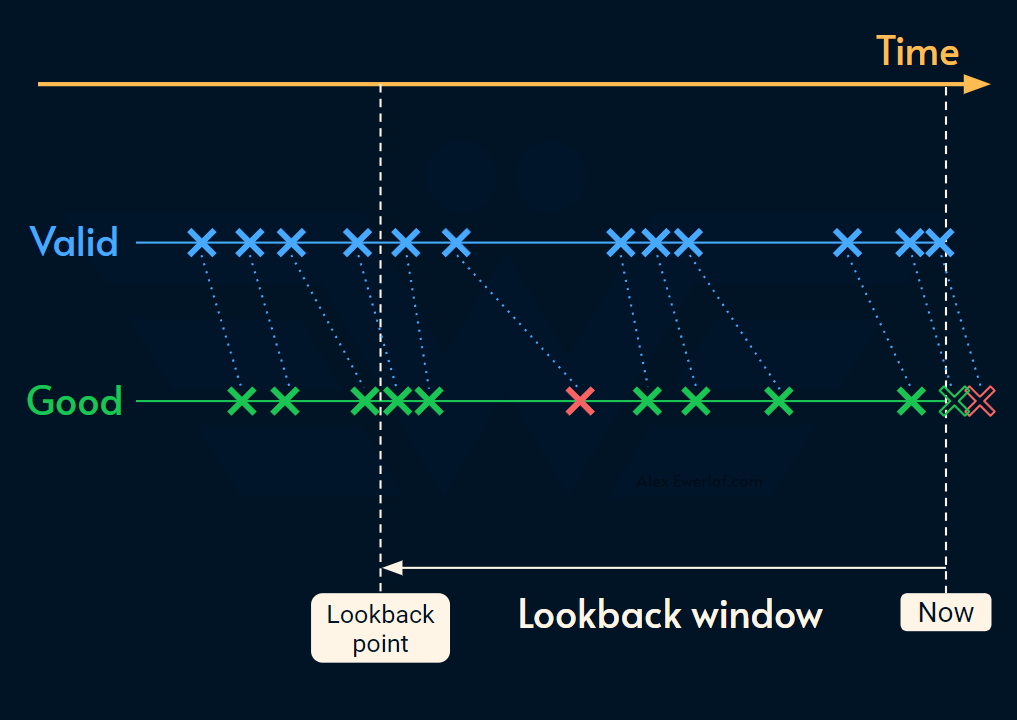Heterogeneous SLI vs Homogeneous SLI
Cons and pros of each approach and when to use which
At the heart of the Service Levels is the ratio between good and valid:
Percentage of
requestswhereresponse.latency < 300msPercentage of
uptime probeswhereresponse.code == 200Percentage of
database recordswherefields.*.age < 365 daysPercentage of
authenticated API requestswherehttp_response.code < 500
When it comes to implement and calculate those percentages, there are two approaches:
Heterogeneous: good and valid are two different metrics with an assumed correlation.
Homogeneous: good and valid come from processing the same metric where good and valid are tightly coupled
This article introduces both types with examples and illustrations ending with a recommendation.
Heterogeneous
This type of SLI queries two different metrics to count the number of:
Good and valid:
or good and bad:
or bad and valid:
Regardless of the approach, it ends up querying two metrics.
Example: Availability of online purchase flow:
Valid: number of unique sessions where the user clicked on the “Pay” button on the check out page
Bad: number of payments failing due to payment gateway issues
Good = Valid - Bad
Note: we deliberately filter out other failures like: when the user doesn’t have enough money, or entered the wrong payment information because you should never be responsible for what you don't control.
On the surface, it looks reasonable, but in practice there are multiple nuances. The biggest issue is the assumed correlation between the datapoints of two different metrics over time:
This is because the data points of two separate metrics don’t exactly match. As a result, for any type of lookback window (e.g. SLS or Alerting), we may end up with an inaccurate measurement.
The problem doesn’t stop at the timestamp level. It is practically impossible to guarantee a 1-1 mapping between valid events and good events when they’re measuring different things, at different locations, and different times.
Another obvious issue is the fact that we need to measure, store, and query two separate metrics (valid and either good or bad).
Pros
Can correlate events across different systems which may map better to how the consumers perceives reliability of the service
Easier to reason about for beginners
Easier to implement by conventional Observability providers (in the next articles we’ll review how Elastic, Datadog, and Grafana implement service levels)
Cons
It might be harder to work with two datasets due to broken correlation between datapoints.
Less efficient due to requiring 2 metrics
Homogeneous
Homogeneous SLIs come directly from the fact that the SLI formula is a percentage:
All you have to do is to:
Filter the metric to only contain valid data points
Go through the data points and count the number of good (or bad) events
Divide it by the total number of data points
It’s easier to show it with a diagram:
The biggest advantage of this method is the reliable correlation between good, bad and valid.
Note: an upcoming feature of SLC, introduces a simulator. It uses an O(1) algorithm to process the metric data in one pass. I’ll write more about that technique once the feature is out.
An obvious advantage of a homogeneous SLI is that it only needs to measure, store, and query one metric.
The downside is that your SLI may not readily be one metric. You may need to use a data processing pipeline that takes in 2 metrics in and spits out a clean homogeneous SLI. This can introduce a delay and cost to your setup.
The good news is that most metrics don’t need this type of processing. For example:
Uptime calculation:divide the percentage of successful probes during the window, multiply by 100Percentage of authenticated requests where latency < 200ms: find all the authenticated requests in the window, filter out any events where latency ≥ 200 and divide this count to the total number of requests x 100
Pros
It is more intuitive because it’s closer to how normalized SLI is literally defined
It requires half as many metrics (only
valid)The SLS calculations essentially turns into a percentile calculation so it is easier to reason about the dataset
Cons
When the good and valid come from different systems, it requires extra processing to corelate the events which adds to the cost and complexity
None of the observability providers that I have investigated (Datadog, Elastic, Grafana) support homogeneous metrics out of the box.
When to use which?
Whether you use homogeneous or heterogeneous metrics depends on how the consumers perceive reliability, your tooling, and budget (time, and money).
Homogeneous metrics are easier to reason about and often come naturally out of the box.
If you can ensure a tight coupling between the two metrics, a heterogenous metric can work too.
These posts take anywhere from a few hours to a few days to ideate, draft, research, illustrate, edit, and publish. I pull these hours from my private time, vacation days and weekends.
Recently I went down in working hours and salary by 10% to be able to spend more time learning and sharing my experience with the public.
My monetization strategy is to give away most content for free because I believe information should be free and accessible. You can support this cause by sparing a few bucks for a paid subscription. As a token of appreciation, you get access to the Pro-Tips sections (on some articles) as well as my online book Reliability Engineering Mindset. Right now, you can get 20% off via this link. You can also invite your friends to gain free access or get a discounted group subscription. There’s also a referral bonus program to gain free subscriptions.
Thanks in advance for helping these words reach further and impact the software engineering community.





